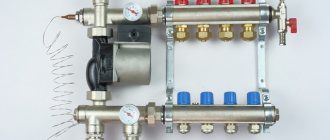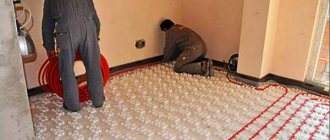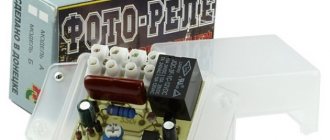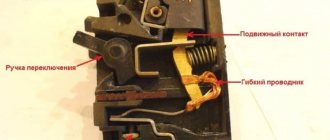Design and purpose of a temperature sensor
The temperature sensor is an important element for ensuring high-quality operation of heated floors. From it, data is sent to the thermostat, which regulates the temperature by increasing or decreasing the power.
Thanks to this, you can set comfortable temperature levels in the room, prevent overheating and damage to the floor covering, and significantly reduce energy costs.
The temperature sensor is simple: two wires connected to a thermocouple - two wires connected at one end. Actually, they are the unit for measuring temperature indicators.
Before pouring the screed, the functionality of the heated floor and the temperature sensor itself is checked. To do this, the resistance of each part is measured. The system works if the difference between the indicators and the values in the technical passport is no more than 10 percent.
Precautionary measures
The main safety measures are as follows:
- Before connecting the device, you must turn off the power to the room.
- The disassembled device cannot be connected to the electrical network.
- The regulator cannot be used if the ambient temperature exceeds +40 degrees.
- The thermostat needs to be cleaned regularly to remove dust.
- Cleaning the device with solvents is strictly prohibited.
It is better for a person who is far from an electrician to carry out the operation of installing or repairing a thermostat on his own. This can cut off power to the entire high-rise building, but also harm your own health.
Features and Benefits
If you do not install thermostats, it is impossible to control the temperature of the heated floor. This is dangerous due to overheating of the device and the creation of an emergency situation. If we talk about the advantages of sensors, we need to consider: the device operates with or without electricity. The advantages of a mechanical regulator include low price and energy independence. The disadvantages include a relatively short period of operation and increased inertia.
The electric device allows you to set the exact temperature and can be controlled remotely. But such a device costs more.
Even more expensive is a programmable device that also runs on electricity. Cunning electronics guard the safety of the home: when the set temperature is reached, the thermostat turns off the heating. Moreover, he can program connection and shutdown for the required time, which saves electricity while people are away from the apartment.
There are options for temperature controllers that are equipped with an external IR sensor. It is able to detect the temperature of the floor covering. The device is powered by a battery and is attached to the wall using Velcro.
Types of temperature sensors for heated floors
There are several types of temperature sensor, here are the main ones:
- With energy saving mode - they allow you to lower the room temperature by a set number of degrees for a certain period when the owners of the house are absent.
- With programming timer – temperature control is performed using a preset timer. It sends signals to the temperature controller, adjusting the heating power at a certain time.
- Intelligently programmable - the device display allows you to set alternating installed heating modes.
- With a limit sensor – allows you to set the minimum and maximum heating power at a set ambient temperature.
Each of the above sensors helps protect against potential overheating, which can harm the integrity of the floor screed.
Functions and selection of thermostat
When choosing a regulator for a heated floor, you need to take into account the following characteristics:
- Technical specifications. Think about which device is suitable - mechanical, electrical or programmable.
- Installation method: surface-mounted, built-in or for mounting on a DIN rail.
- Stylistics. The thermostat can be of different shades and shapes (square, circle).
- Number of channels. Devices can be single-channel or dual-zone.
The control also differs - it can be carried out mechanically, electronically or sensory.
Types of temperature sensors
The classification of thermostats according to their operating principle was considered when reviewing their advantages and disadvantages. But it’s worth learning more about how they work.
Electromechanical
The simplest and most inexpensive type of regulator. Its main working part is a special metal plate that reacts to an increase or decrease in temperature. The system is turned on and off by changing the curvature of the plate during heating and cooling. It will not be possible to set the exact temperature value on such a regulator.
Electronic
The device contains a special element that produces a special signal. Power depends directly on the ambient temperature values. On such devices, you can set precise heating temperature indicators down to a fraction of a degree. The system is controlled via buttons and a small screen.
Programmable
The most expensive of thermoelements. You can set certain values on it, upon reaching which the entire system is turned on or off by the regulator. Thanks to the device, a microclimate is created in the room that suits a specific person. It is possible to configure the thermostat so that the system turns on at a certain time. That is, the floors are heated before the owner comes home, and electricity is not consumed when the owner is away.
Many models have a bright and stylish design, and are also equipped with LCD screens that display information and facilitate precise settings.
Purpose and principle of operation of the thermostat
Thermostat for heated floors
The main purpose of installing a thermostat is to control the heating of the heated floor to achieve optimal performance. The amount of electricity consumption also depends on the functionality of this device.
The device consists of a control device and sensors, information from which is taken into account when turning heat mats on and off. Thanks to the operation of the thermostat, an even temperature is maintained in the rooms and energy consumption is minimized.
The operating principle of the device depends on the underfloor heating system:
- in water it regulates the volume of coolant entering the system;
- in electric ones it regulates the current power and operating time of the heating elements.
Thermostats are easy to use. Their operating mode can be changed at your discretion, even several times a day, without fear of breakdown or premature failure of the equipment. The minimum temperature can be adjusted separately for each room. Some models allow pre-programming of the device’s operating mode at different times of the day.
Sensor selection rules
A temperature sensor for a heated floor is selected taking into account such characteristics as power, type of top covering, installation method and additional functionality.
Power
The value must necessarily meet the requirements and load of the heated floor. Otherwise, the sensor will not operate correctly. When the power of the heating element is greater than that of the regulator itself, it becomes necessary to additionally install a magnetic starter between them - to prevent damage to the device due to increased load.
Feature Set
The heated floor is controlled by an electrical unit, which allows you to configure the operation of the heating elements. Modern regulators have such functionality as starting and de-energizing the system, adjusting temperature conditions, and also setting the frequency of connecting and switching off the heating element.
Ease of use
If you don't think you can handle programming, you shouldn't buy a complex device. Even taking into account all its functionality. For example, it is quite problematic for older people to understand programmable devices. They are better off choosing the mechanical option.
Easy to connect
The accompanying documentation for the thermostat always indicates how to connect the heated floor sensor. The terminals are located at the edge on one side of the control unit. Having connected the electrical wires according to the diagram, you will need to check the functionality of the heating system. To do this, measure the resistance at the terminals of the temperature sensor and the heating electric cable, or connect a heated floor and increase the temperature values from zero to the value recommended by SNIP, that is, up to 30°C.
Appearance
The temperature sensor should not only be functionally understandable, but also attractive in design. Modern regulators are available in various color and shape variations. You can choose an option that harmonizes with the interior of the room.
Criterias of choice
What is important to know when choosing a thermostat for a heated floor
When purchasing a thermostat, you need to know certain nuances. This will allow you to pay only for the necessary functions, as well as ensure the longevity of the heating system and the device itself.
When selecting, you can focus on the following parameters:
- For installation in small rooms, it is advisable to choose an inexpensive mechanical or electronic thermostat with an internal air temperature sensor.
- It makes sense to buy a programmable thermostat if you need multi-zone temperature control, as well as to save energy when there are no residents at home during the daytime.
- The thermostat must correspond to the maximum power of the heating elements with a reserve of 25-30% in case of operation at reduced voltage and will extend the service life of the device.
- For houses with wooden trim, only overhead thermostat boxes are suitable.
- When choosing the type of device, you should proceed from your preferences, design features of the premises and financial capabilities.
To match the floor covering, you need to take into account 2 more parameters:
- Installation method: surface or built-in.
- Type of power supply: for a water floor, a device up to 3 Amp is enough, for an electric one - 16 Amp.
When choosing a thermostat, evaluate the quality of the plastic case. If the manufacturer skimps on this, you can doubt the reliability of the internal components of the device.
Features of choice depending on the floor covering
Sensors for the “warm floor” system are divided according to the type of coating they are installed under. However, the installation differs.
Under soft cover
A temperature sensor mounted under carpet, linoleum, or cork flooring is a small cylinder attached to the end of a piece of cable. Place it when the screed is completely set. To do this, a narrow groove is made in it.
Under hard surface
Mounted, for example, under wood, tiles. The temperature sensor here is larger and covered with gel that protects it from damage. Its installation is somewhat more complicated and can be direct or using a mounting box.
How to regulate the temperature in the house - 3 ways and determining the optimal mode
The main task of maintaining temperature conditions is to create comfortable living conditions, subject to optimal use of resources. This can be achieved in several ways.
The first of them is to set the optimal degree of heating of the coolant in the underfloor heating circuits.
The second is the complete cessation of its entry into it. The easiest way is to use pipes with a maximum operating temperature of 90-95 degrees for the heating circuit. This allows you to install a circular pump with a thermostat in the system, as well as a reverse valve.
The installation location of the pump is the return pipe, and the temperature of the coolant in this place is no more than 70-80 degrees Celsius. If the heating of the coolant reaches critical values, the thermostat turns off the pump and the heating goes into standby mode.
As the floor cools, the circulation pump turns on again, supplying a new dose of hot water into the circuit pipeline. Practice shows that this method is the most effective and reliable for stable heating operation with heated floors.
If a 3-way valve is used, adjustment can be made manually or via a servo drive. The mixing valve regulates the temperature of the coolant according to a pre-entered control value.
The third method of adjusting the heating of the coolant in a home heating system
consists of using a mixing unit. Such a device can be made from the following components:
- 3-way valve;
- circulation pump;
- bypass jumper;
- thermometer;
- thermostatic head;
- maximum temperature control relay.
Considering the composition of the components used, the unit for adjusting the degree of heating in the heating system turns out to be quite expensive.
But the temperature change in it occurs very quickly, because it is produced by mixing water from the return pipe into the main coolant flow. In this case, the combustion intensity in the boiler automatically decreases.
In accordance with the established regulations, the fuel consumption mode is always optimal.
The number of nodes in the combined system can be any, and each will work autonomously in accordance with the established settings.
Thus, it is possible to maintain a higher air temperature, for example, in a children's room and at the same time a lower one in the bedroom of adult members of the family. Such a unit is especially effective for controlling the temperature in the installation of water floors.
To use this method of adjustment there is only one requirement - the entire heating circuit must be arranged in accordance with European requirements. The temperature of hot water from the boiler should not exceed 67 degrees.
And now we will consider the method of adjusting the thermal and hydraulic conditions using a thermostat. It is installed in a room, and adjustment is made by setting this device to the desired temperature for that particular point. Heating is controlled by a servo drive on a specific circuit.
Watch the video
Automatic water heated floor
Such a device works successfully in conjunction with a homemade manifold, a three-way valve and a mixing unit. Its popularity is due to the ease of adjusting the heating mode and the relative cheapness of the device.
Find out how water heated floors work depending on the type of connection.
Installation sequence
Before installing the regulator, be sure to read the attached technical documentation. It is best to install the thermostat next to sockets at a height of 60–100 cm from the floor. Before installation work, turn off the electricity in your home network.
Directly
To install a temperature sensor using this method, the regulator and heating cable are connected directly. With this type of connection, the heating element itself is in conjunction with the thermostat.
Using a junction box
This part is used as an intermediate part between the thermal device and the heating element. The connection diagram is as follows: one cable is pulled from the regulator to the wiring block, and another to the heating wire.
In order to mount the regulator you will need: corrugated tube, screwdriver, mounting screws, mounting box, level, indicator.
Step-by-step installation instructions:
- A hole is cut in the wall for a box for mounting a thermal device. Below is a groove for pulling electrical wires. The box is placed in the right place.
- Electrical wiring is being pulled. The power cable and temperature sensor element are connected to the junction box.
- The electrical wires are connected to the thermostat, after which it is mounted in the box and secured.
- The main system components are connected to the product in accordance with the technical documentation.
- Once finished, the front panel is leveled and secured with screws.
Continuous operation of the heating system should begin no earlier than 3–4 weeks after pouring the screed. And if you chose tiles, after laying them. Under the influence of heat, the screed may simply burst.
How to choose a thermostat for a heated floor
We told you about the best models of thermostats for heated floors. Konstantin Livanov, a repair specialist with 30 years of experience, will tell you how to choose a device for this, together with Komsomolskaya Pravda
Installation location
It is important to think about where you will install the thermostat in your home. It is important that all cables are routed to it. And if you have a model for an outlet frame, then this very frame should be ready. Also, if there is a small child at home, put the thermostat higher so that playful little hands don’t get into trouble.
Wall thermostats
There are different thermostats, but the most popular format is wall-mounted
What kind of underfloor heating do you have?
Here you need to take into account not only the type (water, electric or infrared), but also the power that will go through the thermostat. As a basis, it is worth taking 3500 W based on a medium-sized room. If the area is larger, then it is worth thinking about distributing it over several devices.
Control
A timeless classic is the mechanical adjustment. It will appeal to those who are accustomed to such interfaces, but such thermostats do not have additional options. Much more advanced is push-button control, where there is fine-tuning and remote control with a programmer. Well, the most advanced ones are touch-sensitive ones, where the controls are collected on the screen, or, less conveniently, on touch buttons.
What to do if the sensor is not installed
The simplest solution is to connect a thermal device that has a built-in control temperature sensor that turns off the heating wire when the air warms up to the required temperature.
If a warm floor is needed only to make the surface pleasant to walk on, a thermostat with a smooth power control mode in the range from 0 to 100 percent is suitable.
The thermostat operates on the principle of a timer. For example, when set to 80 percent for 10 minutes, electricity flows to the heating element for 8 minutes, but not for 2 minutes.
There are regulators that can automatically switch to timer mode.
Installation rules
Features of installing a thermostat
The process of installing a thermostat is not particularly difficult, but the technician needs minimal knowledge about the design of the devices. The installation location is determined based on the power of the heated floor and the device itself. The thermostat is located at a remote distance from the heating elements, otherwise when they are turned on, it will turn off the electrical circuit.
The device must be equipped with electrical cables and wiring for temperature sensors. To do this, appropriate grooves are made in the plate. In them, cables are laid on the electrical panel and on the floor. If the heating system is installed in a room with high-quality interior finishing, you can use hanging devices and run cables to the walls in boxes. The cables to the thermostat terminals must be connected according to the diagram in the manual.
When installing and connecting, it is important to adhere to the following recommendations:
- It is advisable to place the regulator at a distance of 40-170 cm from the floor, unless otherwise indicated in the instructions. With a movable control panel, the main unit can be installed in any convenient location.
- The main functions of a floor sensor are to prevent overheating of the floor covering and ensure foot comfort, but not to control the air temperature in the room.
- In humid environments, thermostats with appropriate protection against water ingress may be used.
- When installing the device into a wall, use a mounting box made of non-combustible materials.
- Cables from the controller to underfloor heating water heaters with a power of more than 1 kW must be laid in heat-resistant hollow pipes.
- The floor temperature sensor must be located between the heating elements at a distance of at least 50 cm from the walls.
- When turned on for the first time, the device is set to the minimum operating temperature specified in the instructions.
- Installation of the thermostat begins after the final installation of the heated floor elements in order to correctly calculate the length of the wires.
- When filling the floor with mortar, the end of the pipe with the sensor must be well insulated.
- Before filling the heating elements, it is necessary to check the operation of all elements of the system.
- Heating mats must be grounded, and an RCD must be installed in front of the thermostat.
Sequence of actions when installing a thermostat:
- De-energize the installation location of the device. The underfloor heating wires should already be connected to the outlet. Remove the insulation from the floor wires - 6 cm;
- Remove the thermostat top panel. To do this, insert a straight screwdriver into the groove from below.
- Connect the cable shields with a yellow-green wire, then place everything in the outlet.
- After installing the sensor in the corrugation, pull one end into the socket box, and place the other between the insulation (floor panels with cable or infrared film).
- Connect the floor wires to the required terminals of the regulator according to the diagram;
- Carefully bend the wires, insert the device into the socket;
- Install the frame and secure the top panel.
- The thermostat is connected, all that remains is to check its operation.
When installing heated floors in conditions of high humidity, it is safer to place the thermostat in adjacent rooms.
How to check a temperature sensor
To find out why the temperature sensor is not working, you can use a multimeter:
- The input line is being tested. You need to turn on the power and check if there is voltage in the wires.
- If no problems are found, the output line is tested. The heating cable is disconnected from the regulator and the power is turned on.
If there is no voltage at the output terminals, we can say that the thermal device has become unusable. It is removed and replaced with a new one.
Review of manufacturers
There are many companies involved in the production of heated floors. The most popular brands are Devi, AEG, Thermo Industri AB. Each manufacturer's sensors have their own characteristics.
Devi devices
Temperature regulators of this brand work with any type of heating elements. They are divided into mechanical and electronic, with conventional or touch controls. In addition, the Devi line of regulators includes models controlled remotely via smartphones.
Advantages of devices of this brand:
- availability of models for outdoor installation;
- savings on the operation of heating appliances up to 30 percent;
- availability of control via the Internet.
The advantage is the variety of options to solve any problem.
AEG regulators
Thermal sensors of the German brand belong to the premium class. Excellent quality guarantees durability and trouble-free operation. But such devices also cost a lot.
The product range is wide: from simple basic devices to “smart” temperature sensors that fully control the operation of the heated floor and the microclimate in the room.
But even basic models have many advantages:
- maintain temperature indicators at the required level;
- controlled very simply - by manually turning the key on and off;
- Thanks to convenient controls, they are suitable for older people who are not familiar with programming.
An external timer can be connected to the device to control the temperature reduction mode.
Devices Thermo Industry AB
Such thermostats are installed exclusively indoors. Capable of controlling elements of a heating cable or thermomat. Models have been developed that are ideal for parquet or laminate flooring. Most devices are equipped with smart air temperature meters.
Electronic devices are capable of adjusting heating with an accuracy of 1°C.
They are used for anti-icing systems if it is possible to combine them with a thermostat in the house. Built-in intelligent heating sensors make it possible to reduce electricity consumption, and Swedish quality guarantees many years of operation.
Types of thermostats
The classification of all thermostats is based on the principle of control and configuration of these devices. Each variety has some advantages and disadvantages.
Mechanical
A device that is easy to set up and operate without electrical components. The function of a temperature sensor in it is usually performed by a bimetallic plate. When cold, it closes the contacts of the heating mats. As the temperature in the room increases, it bends and disconnects the electrical circuit, as a result of which the floor heating stops.
The mechanical device is adjusted using a wheel, which can be rotated to adjust the temperature. Despite their simplicity, mechanical thermostats have a strong hold on the market.
It has a number of advantages and disadvantages:
- low price.
- ease of operation.
- ability to work at low temperatures.
- reliability;
- independence from voltage surges;
- long service life;
- automatic switching on after a power outage.
- minimal functionality;
- lack of remote control capability;
- large error in tinctures;
- the presence of fairly loud clicks when bending the bimetallic plate.
Electronic
This type of thermostat is similar to mechanical types in terms of operation and functionality. The device is equipped with a digital display (on which indicators are displayed) and a heated floor and air temperature sensor. The parameters are set manually. The user can control the temperature with an accuracy of 0.5 degrees.
Device advantages and disadvantages:
- flexible regulatory program;
- presence of a remote control;
- ability to connect to other control systems.
- high cost and difficulty of self-regulation.
Programmable
The main difference between programmable thermostats and conventional electronic ones is the expanded functionality of the control microcircuit. This device can be programmed to turn on at a certain time of the day, and several heating modes can be set on it: minimal, optimal and economical.
Modern programmable models may provide a remote control function from a smartphone via Wi-Fi. Some manufacturers of thermostats produce their own applications for smartphones, by installing which you can configure the equipment from your gadget.
The disadvantages of this device include the high cost and difficulty of setting up in the absence of skills in handling the equipment. Otherwise, the pros and cons of programmable thermostats are the same as conventional electronic ones.
In electronic and programmable thermostats, internal components can be divided into two blocks: main and mobile. Electrical cables are connected to the main box and wired temperature sensors are connected. It can be placed in any remote location of the room, which makes installation easier.
The battery-powered mobile unit is used as a remote control. It can lie on a table or hang on the wall. Additionally, the consoles can be equipped with external temperature sensors that measure the ambient air temperature. Such devices are convenient because they allow you to hide the adjustment mechanism from children.











